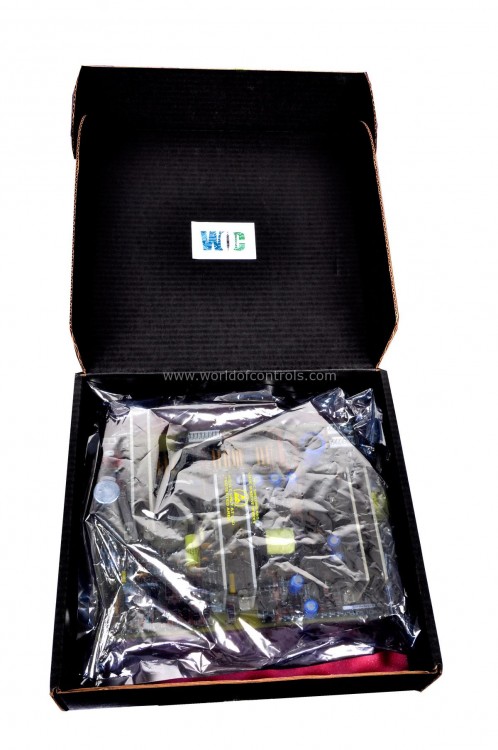SPECIFICATIONS
Part No.: DS200EXCSG1ABA
Manufacturer: General Electric
Country of Manufacture: United States of America (USA)
PCB Coating: Conformal
Technology: Surface-mount
Temperature Operating: -30 to 65oC
Product Type: Exciter Conduction Sensor Board
Availability: In Stock
Series: EX2000
Functional Description
DS200EXCSG1ABA is an exciter conduction sensor board developed by GE. It is a part of EX2000 excitation system. The EXCS board detects current flow within a bus line. To achieve this, the board is equipped with gapped steel rings that are strategically attached to it. These rings serve as a conduit for the bus line, allowing current to pass through them. The design of the rings incorporates intentional gaps, which are essential for creating a measurable magnetic field.
Features
- Measurement Principle: The detection of current flow is facilitated by Hall Effect sensors integrated into the board. These sensors are positioned to measure the concentrated magnetic flux generated within the steel rings when current flows through the bus line. The Hall Effect is a physical phenomenon where a voltage difference (Hall voltage) is produced across a conductor when subjected to a magnetic field perpendicular to the current flow. By detecting changes in this Hall voltage, the sensors can accurately determine the magnitude and direction of the current passing through the rings.
- Mounting and Stability: To ensure accurate measurement and reliable operation, the board is securely mounted directly onto the bus line using a plastic mounting bracket. This bracket serves two primary purposes: it holds the steel rings in place, maintaining their alignment and positioning, and it provides a stable platform for the board itself. The robust mounting mechanism minimizes the risk of movement or displacement, which could compromise the accuracy of current measurements.
- Plastic Mounting Bracket: The plastic mounting bracket is specifically designed to withstand the environmental conditions and mechanical stresses encountered in the operating environment. Its durable construction ensures long-term stability and protection for the sensitive components housed within the EXCS board. Additionally, the material properties of the bracket are carefully chosen to minimize interference with the magnetic field measurements, allowing the sensors to operate optimally without distortion or attenuation.
System Features
- Power Source and Exciter Configuration: In the Potential Source Excitation System, power for the exciter is commonly sourced from a Power Potential Transformer (PPT) directly connected to the terminals of the generator. Alternatively, excitation power can be obtained through an excitation transformer linked to an auxiliary bus. This configuration provides flexibility in excitation system design and operation.
- Versatile System Configurations: The exciter's hardware and software components offer flexibility, allowing for various system configurations tailored to specific requirements. With appropriate hardware and software adjustments, the basic exciter and protection cores can be configured as:
- Compound System: A configuration where the excitation system is designed to provide both automatic voltage regulation (AVR) and power factor control.
- ALTERREXTM and GENERREXTM Systems: These configurations incorporate advanced features and capabilities for enhanced performance and reliability.
- Multiple Bridge System: An arrangement that utilizes multiple bridge circuits for redundancy and fault tolerance.
- Hot Backup System: In this setup, a redundant excitation system is kept in standby mode, ready to take over in case of failure in the primary system.
- Master-Master System: A configuration where multiple excitation systems operate in parallel, with each capable of assuming control as needed.
The WOC team is always available to help you with your EX2000 requirements. For more information, please contact WOC.
Frequently Asked Questions
What is DS200EXCSG1ABA?
It is an exciter conduction sensor board developed by GE under the EX2000 series.
What role does the AC regulator play when the generator is isolated from the system?
When the generator is isolated from the system, the AC regulator controls the terminal voltage, while the reactive power (VARs) is determined by the load. This setup ensures that the terminal voltage remains within specified limits even in isolation.
How does the AC regulator operate under normal system conditions?
Under normal system conditions, most generators operate with the AC regulator controlling both the terminal voltage and the VARs. This allows for precise regulation of both parameters to maintain system stability and efficiency.
What happens in situations between isolation and normal operation?
In many scenarios, generators operate in a manner that falls between isolation and normal operation. This means that both VARs and volts are controlled by the AC regulator, allowing for dynamic adjustment based on system requirements and load conditions.
